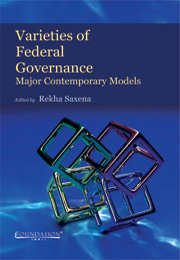Book contents
- Frontmatter
- Contents
- List of Contributors
- Foreword
- Acknowledgements
- Introduction
- I Theoretical and Comparative Dimensions
- II Presidential Federal Systems
- III Commonwealth Parliamentary Federations
- 8 Constitutional Normalization in Canada: The Significance of Failure of the Charlottetown Agreement
- 9 The Australian Senate: Form, Function and Effectiveness
- 10 Federalizing India's Political Parties: National All-India and National Interstate Parties
- 11 Malaysia: Centralized Federalism in an Electoral One-Party State
- 12 Promises Unmet: Multi-level Government in South Africa
- IV Non-Commonwealth Parliamentary Federations in Afro-Asia
- V European Parliamentary Federations
- VI Devolutionary Systems
- VII Supranational Confederalism/Federalism?
9 - The Australian Senate: Form, Function and Effectiveness
from III - Commonwealth Parliamentary Federations
Published online by Cambridge University Press: 05 June 2012
- Frontmatter
- Contents
- List of Contributors
- Foreword
- Acknowledgements
- Introduction
- I Theoretical and Comparative Dimensions
- II Presidential Federal Systems
- III Commonwealth Parliamentary Federations
- 8 Constitutional Normalization in Canada: The Significance of Failure of the Charlottetown Agreement
- 9 The Australian Senate: Form, Function and Effectiveness
- 10 Federalizing India's Political Parties: National All-India and National Interstate Parties
- 11 Malaysia: Centralized Federalism in an Electoral One-Party State
- 12 Promises Unmet: Multi-level Government in South Africa
- IV Non-Commonwealth Parliamentary Federations in Afro-Asia
- V European Parliamentary Federations
- VI Devolutionary Systems
- VII Supranational Confederalism/Federalism?
Summary
The framers of the Australian Constitution were well aware of the conceptual difficulties in accommodating responsible government with federalism. Under the system of responsible government, a government is formed from and is accountable to the popularly elected House of Parliament. It ceases to hold office when it loses the confidence of that House. Federalism entails a division of power and a system of checks and balances. As Brian Galligan has put it, ‘[t]he purpose of responsible government is to unify and consolidate political power whereas that of federalism is to fragment and circumscribe its exercise’ by enshrining ‘complicated procedures and conflicting institutions within the democratic process in order to refine and restrict the majority will’. The modern Australian Senate continues to manifest the tensions between these principles. But it does so as a House thoroughly dominated by party allegiances and in which territorial representation is vastly attenuated. It is able (and motivated) to check government much of the time, not because it represents discrete state interests, but because the government rarely controls the Senate.
The Constitutional Design
Composition and Representation
Section 1 of the Australian Constitution (1900) establishes the Senate as one of the three components of the Federal Parliament in which the legislative power of the Commonwealth is vested (the others are the Queen and the House of Representatives). In accordance with the traditions of British bicameralism, the concurrence of all three components of the Parliament is necessary to enact legislation.
- Type
- Chapter
- Information
- Varieties of Federal GovernanceMajor Contemporary Models, pp. 142 - 174Publisher: Foundation BooksPrint publication year: 2011



